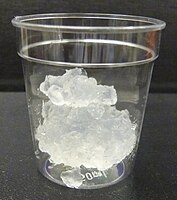
Cross‐Linking Dynamics of Cellulose Nanofibrils‐Based Transient Network Hydrogels: A Study of pH Dependence
Sign Up to like & getrecommendations! Published in 2017 at "Macromolecular Chemistry and Physics"
DOI: 10.1002/macp.201600584
Abstract: Interactions between polymer chains and nanoparticles can play a dominant role in composites mechanics, yet the control of such interfacial dynamics is still a significant challenge. This paper reports the effect of pH on cellulose… read more here.
Keywords: dependence; network; cross linking; cellulose nanofibrils ... See more keywords

Reusable and cross‐linked cellulose nanofibrils aerogel for the removal of heavy metal ions
Sign Up to like & getrecommendations! Published in 2018 at "Polymer Composites"
DOI: 10.1002/pc.24536
Abstract: Reusable and porous aerogel was fabricated using natural cellulose nanofibrils (CNFs) cross-linked with acrylic acid (AA) for the removal of heavy metal ions. CNFs with diameters of 5–50 nm were obtained and the cross-linking mechanism… read more here.
Keywords: adsorption; metal ions; cross; heavy metal ... See more keywords

Exploiting poly(ɛ‐caprolactone) and cellulose nanofibrils modified with latex nanoparticles for the development of biodegradable nanocomposites
Sign Up to like & getrecommendations! Published in 2019 at "Polymer Composites"
DOI: 10.1002/pc.24865
Abstract: This study reports the development of nanocomposites based on poly(?-caprolactone) (PCL) and cellulose nanofibrils (CNF) modified with cationic latex nanoparticles. The physical adsorption of these ... read more here.
Keywords: cellulose nanofibrils; development; poly caprolactone; latex nanoparticles ... See more keywords

In-situ synthesised hydroxyapatite-loaded films based on cellulose nanofibrils for phenol removal from wastewater
Sign Up to like & getrecommendations! Published in 2017 at "Cellulose"
DOI: 10.1007/s10570-017-1435-2
Abstract: Phenol removal from aqueous medium was studied by the batch method using novel and fully biobased solvent-cast films prepared from cellulose nanofibrils (CNFs) and in situ synthesised hydroxyapatite (HAp) by the wet-chemical precipitation method and… read more here.
Keywords: phenol removal; adsorption; situ synthesised; water ... See more keywords

Contribution of lignin to the surface structure and physical performance of cellulose nanofibrils film
Sign Up to like & getrecommendations! Published in 2018 at "Cellulose"
DOI: 10.1007/s10570-018-1658-x
Abstract: Herein, lignocellulosic nanofibrils (LCNF) suspension containing 0.1, 3.9, and 17.2 wt% lignin were utilized to fabricate films by filtration and pressing process. The stiff nature of fibrils containing lignin made them less able to conform… read more here.
Keywords: lignin; surface; film; cellulose nanofibrils ... See more keywords

Optimization of carboxymethylation reaction as a pretreatment for production of cellulose nanofibrils
Sign Up to like & getrecommendations! Published in 2018 at "Cellulose"
DOI: 10.1007/s10570-018-1853-9
Abstract: We investigated the optimal reaction conditions for carboxymethylation as a pretreatment method for the production of cellulose nanofibrils (CNF). The influence of the reaction sequence, solvent composition, and presence of water in the reaction medium… read more here.
Keywords: carboxymethylation reaction; reaction; production cellulose; carboxymethylation ... See more keywords

Cationic cellulose nanofibrils as a green support of palladium nanoparticles: catalyst evaluation in Suzuki reactions
Sign Up to like & getrecommendations! Published in 2018 at "Cellulose"
DOI: 10.1007/s10570-018-2085-8
Abstract: Cationic cellulose nanofibrils (C-CNF) were used as a support for the growth and the immobilization of Pd NPs using PdCl2 as precursor. The ensuing Pd@C-CNF nanocomposite was tested as a catalyst for the Suzuki coupling… read more here.
Keywords: palladium nanoparticles; cationic cellulose; suzuki; cellulose nanofibrils ... See more keywords

A new protocol for efficient and high yield preparation of cellulose nanofibrils
Sign Up to like & getrecommendations! Published in 2018 at "Cellulose"
DOI: 10.1007/s10570-018-2112-9
Abstract: Nanocellulose has attracted considerable attention in virtue of the unique mechanical and optical properties. There were less cost-efficient methods for its mass production. In this paper, a facile high yield procedure for cellulose nanofibrils consisting… read more here.
Keywords: protocol efficient; new protocol; high yield; efficient high ... See more keywords

Xylanase pretreatment of wood fibers for producing cellulose nanofibrils: a comparison of different enzyme preparations
Sign Up to like & getrecommendations! Published in 2019 at "Cellulose"
DOI: 10.1007/s10570-019-02250-1
Abstract: Three commercial xylanases and an endoglucanase preparation were compared in the enzymatic pretreatment of bleached eucalyptus pulp for producing cellulose nanofibrils (CNFs) through subsequent microfluidization. Commercially provided xylanases X10A and X10B hydrolyzed more xylan than… read more here.
Keywords: xylanase; producing cellulose; xylanases x10a; cellulose nanofibrils ... See more keywords

Carboxymethylated cellulose nanofibrils in papermaking: influence on filler retention and paper properties
Sign Up to like & getrecommendations! Published in 2019 at "Cellulose"
DOI: 10.1007/s10570-019-02303-5
Abstract: The papermaking industry competitiveness has been exponentially increasing. In order to improve the paper properties, processes have to be optimized in such a way that new horizons, such as the synthesis of new materials, are… read more here.
Keywords: paper properties; filler retention; paper; filler ... See more keywords

Structural and functional modification of cellulose nanofibrils using graft copolymerization with glycidyl methacrylate by Fe2+–thiourea dioxide–H2O2 redox system
Sign Up to like & getrecommendations! Published in 2019 at "Cellulose"
DOI: 10.1007/s10570-019-02411-2
Abstract: To graft epoxy and ester functional groups onto cellulose nanofibrils (CNFs) and to overcome their poor hydrophobicity, we studied the modification of CNFs using graft copolymerization with glycidyl methacrylate (GMA) by a Fe2+–thiourea dioxide–H2O2 initiator… read more here.
Keywords: system; h2o2; copolymerization; graft copolymerization ... See more keywords